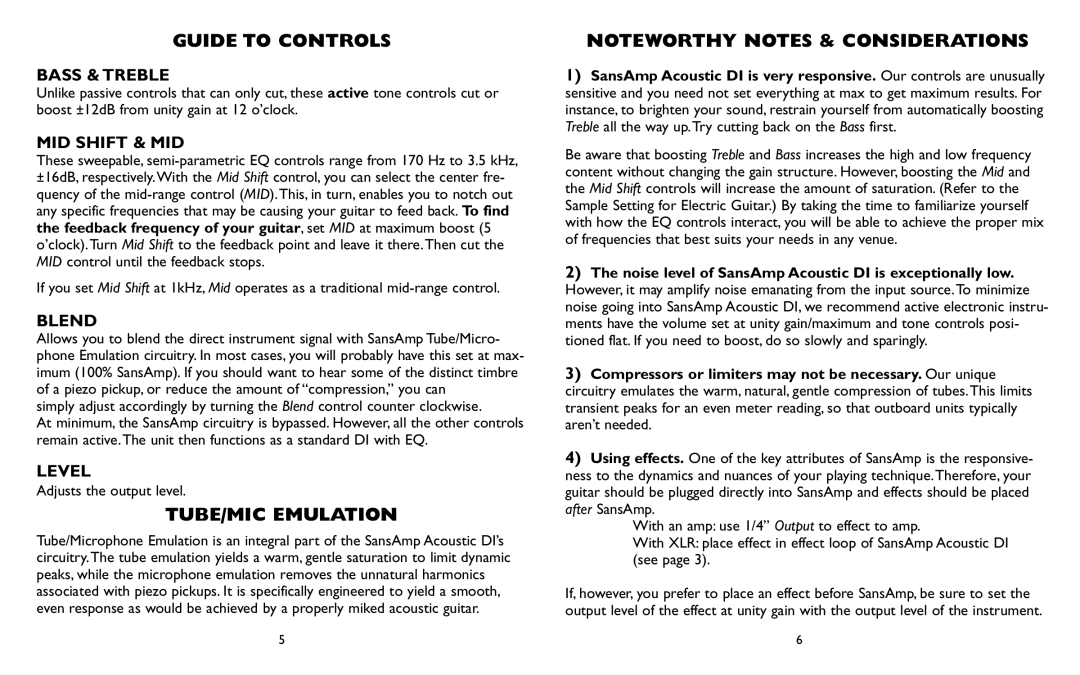GUIDE TO CONTROLS
BASS & TREBLE
Unlike passive controls that can only cut, these active tone controls cut or boost ±12dB from unity gain at 12 o’clock.
MID SHIFT & MID
These sweepable,
If you set Mid Shift at 1kHz, Mid operates as a traditional
BLEND
Allows you to blend the direct instrument signal with SansAmp Tube/Micro- phone Emulation circuitry. In most cases, you will probably have this set at max- imum (100% SansAmp). If you should want to hear some of the distinct timbre of a piezo pickup, or reduce the amount of “compression,” you can
simply adjust accordingly by turning the Blend control counter clockwise.
At minimum, the SansAmp circuitry is bypassed. However, all the other controls remain active. The unit then functions as a standard DI with EQ.
LEVEL
Adjusts the output level.
TUBE/MIC EMULATION
Tube/Microphone Emulation is an integral part of the SansAmp Acoustic DI’s circuitry. The tube emulation yields a warm, gentle saturation to limit dynamic peaks, while the microphone emulation removes the unnatural harmonics associated with piezo pickups. It is specifically engineered to yield a smooth, even response as would be achieved by a properly miked acoustic guitar.
NOTEWORTHY NOTES & CONSIDERATIONS
1)SansAmp Acoustic DI is very responsive. Our controls are unusually sensitive and you need not set everything at max to get maximum results. For instance, to brighten your sound, restrain yourself from automatically boosting Treble all the way up. Try cutting back on the Bass first.
Be aware that boosting Treble and Bass increases the high and low frequency content without changing the gain structure. However, boosting the Mid and the Mid Shift controls will increase the amount of saturation. (Refer to the Sample Setting for Electric Guitar.) By taking the time to familiarize yourself with how the EQ controls interact, you will be able to achieve the proper mix of frequencies that best suits your needs in any venue.
2)The noise level of SansAmp Acoustic DI is exceptionally low. However, it may amplify noise emanating from the input source. To minimize noise going into SansAmp Acoustic DI, we recommend active electronic instru- ments have the volume set at unity gain/maximum and tone controls posi- tioned flat. If you need to boost, do so slowly and sparingly.
3)Compressors or limiters may not be necessary. Our unique circuitry emulates the warm, natural, gentle compression of tubes. This limits transient peaks for an even meter reading, so that outboard units typically aren’t needed.
4)Using effects. One of the key attributes of SansAmp is the responsive- ness to the dynamics and nuances of your playing technique. Therefore, your guitar should be plugged directly into SansAmp and effects should be placed after SansAmp.
With an amp: use 1/4” Output to effect to amp.
With XLR: place effect in effect loop of SansAmp Acoustic DI (see page 3).
If, however, you prefer to place an effect before SansAmp, be sure to set the output level of the effect at unity gain with the output level of the instrument.
5 | 6 |
